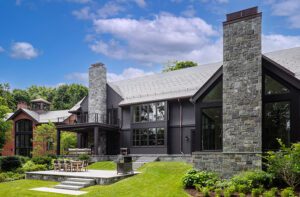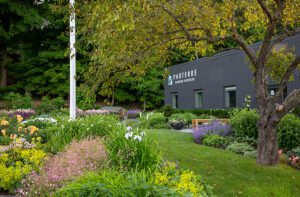Motion Studies
November 3, 2010
Text by O’rya Hyde-Keller Photography by Portrait by Webb Chapell
When Toots Zynsky was a girl, there was nothing she wanted more than to be a dancer. Well-meaning friends and family in her small New England town cautioned against it, saying she was too tall, too big-boned. So she didn’t pursue it. “Everyone thought they were doing me a favor by discouraging me,” she says. “But people should never tell kids that stuff. You can break any barrier you want if you’re determined to do it. Now I turn my head away when people tell me something is impossible.”
The dance world’s loss was the art world’s gain. The experience inspired her never to back off from a challenge again. And her early passion for grace in motion led her to invent a singular form of glass artistry she calls filet-de-verre. Zynsky takes thousands of multi-colored, cappellini-thin glass threads and arranges them in complex layers on a fiberglass board, a process she likens to painting or drawing. The threads are then thermally fused in a kiln. Zynsky then uses molds and her hands to squeeze and shape the hot glass into brilliant sinuous cylinders. Her work is in the permanent collections of more than seventy museums and public collections worldwide, including the Smithsonian, the Louvre and the Metropolitan Museum of Art. She was the first contemporary glass artist to have a piece commissioned by New York’s Museum of Modern Art. She also has a devoted coterie of private collectors.
She may not have become a dancer, but there’s no doubt that a balletic instinct informs her trademark vessels. They are freeze-frames of fluctuation, undulating lines and colors formed into objects that look as if they’ve been plucked from some Pixar-animated ocean floor. Just as she was discouraged from her dream of dancing, Zynsky was told filet-de-verre would never work. “When she was proposing to create pieces using these bundles of glass fibers, she was told that it couldn’t be done,” says John Fairbanks, curator emeritus of American decorative arts at Boston’s Museum of Fine Arts. “It was a challenge, so of course she made it happen.”
It took time to perfect the technique, though, and the process was one of trial and error, of broken and over-melted glass. In 1982, with a small National Endowment for the Arts grant, Zynsky headed to Europe, where her dollars would go further and last longer, so she could figure out a better way to create glass threads than pulling them by hand. In Holland she met Mathijs Teunissen van Manen, an artist and inventor who helped her create the machines that would eventually do it mechanically. Today, the machines incorporate sophisticated electronics and special computer software.
Before her European adventure, Zynsky attended the Rhode Island School of Design in Providence, but she struggled to find a concentration that truly inspired her. Painting, drawing, sculpture—they were all too still, too slow. One day she happened upon a class taught by renowned glass artist Dale Chihuly. “The first time I saw glass-blowing, I fell in love with it because it looked like this wonderful, spontaneous choreography of many bodies moving in the same place,” she says. “And like dance, there was this constant awareness of everyone around you.”
Under Chihuly’s tutelage she began to experiment with glass in different ways—blowing, casting, pate de verre, even doing performance pieces in which she would shatter and melt glass before an audience. It was the dawn of the modern glass movement, a thrilling time to be a young artist in the field. “Glass had never been developed though impressionism, cubism, Dadaism, abstract impressionism, minimalism, conceptualism. . . . It was like there was this huge catching up that had to be done,” she says. “So it meant that every-thing was, in principle, possible.”
The work that eventually made her famous is a more solitary pursuit than the active group dynamic that initially brought her to the medium. Even so, her art is still all about motion, reflected in the interplay between threads as they melt together and in the flowing parabolas of her finished pieces. “Part of the reason I developed this work was because I wanted to spend more time contemplating each piece,” she says. “When you’re working with hot blown glass, it’s very fast, and there’s no going back. But I’m still always thinking about motion, and so the pieces have become more and more fluid in their form.”
In 1999, after more than two decades in Europe, Zynsky moved back to Providence’s East Side. Her machines are housed at her studio in an old mill building in nearby Pawtucket, Rhode Island. On a recent busy day, Zynsky flitted through the cavernous space attending to one thing and another. One assistant manned the machines that transform glass rods from Murano, Italy, into threads. Another was on the phone, coordinating shipping for an upcoming show. As Zynsky pored through photos of a recent piece, trying to figure out which one to send to a gallery, she was interrupted by a young artist she is mentoring who needed help using one of the studio’s three kilns. From its wire enclosure, a longhaired bunny, recently evicted from Zynsky’s daughter’s apartment, looked on.
Zynsky is back in motion after a long period of stops and starts. Recently, over the course of just a few years, eight close friends and family members, including her parents and the co-inventor of her threading machines, died. She spent much of that time taking care of loved ones and then mourning their passing. When she finally got back to her studio, the only color she wanted in front of her eyes was red, a hue she calls the color of life. “I covered up all the other colors,” she says. “And then I made a piece that went from black to red, and then I started with all the nuances in different sizes and shapes. It was the first time it felt really good to be working again.”
She sent images of the vessels to Barry Friedman, the owner of the gallery she works with in New York City. Friedman loved them and said he wanted to build a show around them, so much so that he sponsored the development of all the red-and-black pieces she created over the next year. Once again, the would-be dancer was leaping forward. “The show was called Shadows, and it was easily the best show I’ve ever done,” she says. “It referred to the shadows we all leave as we pass through our time on Earth and then move on. It was about that combination of darkness and brilliance that a life is all about. It was about pulling me out of darkness and into the light.”
EDITOR’S NOTE: Toots Zynsky is represented in New England by Dane Gallery, Nantucket, Mass., (508) 228-7779, www.danegallery.com
Share
![NEH-Logo_Black[1] NEH-Logo_Black[1]](https://b2915716.smushcdn.com/2915716/wp-content/uploads/2022/08/NEH-Logo_Black1-300x162.jpg?lossy=1&strip=1&webp=1)


















You must be logged in to post a comment.